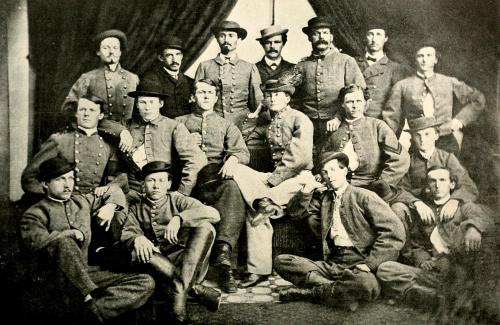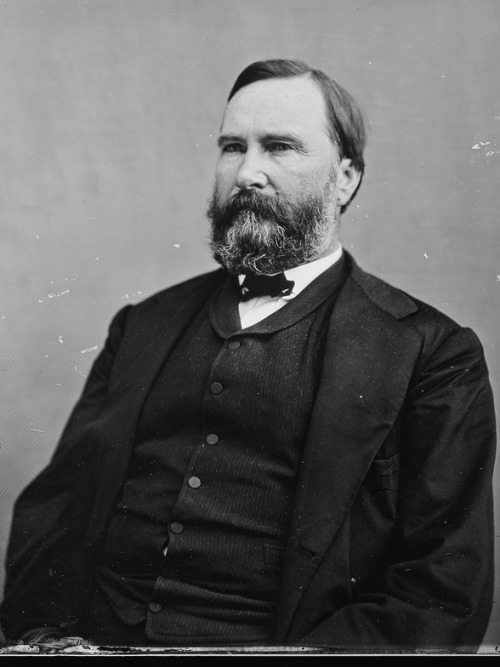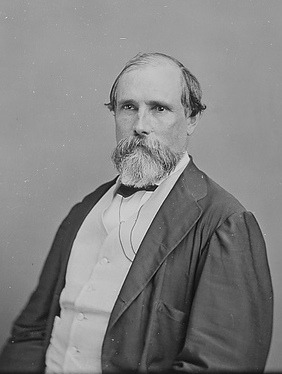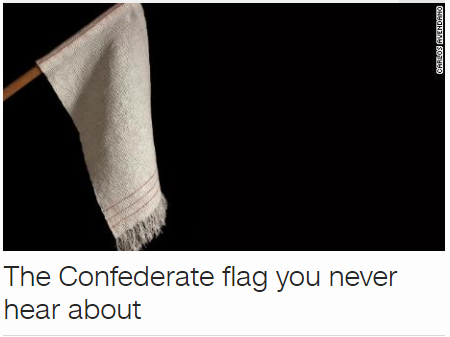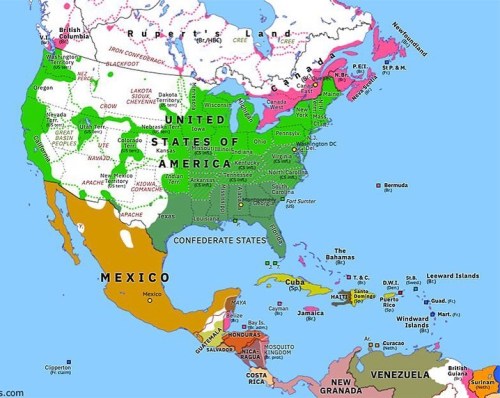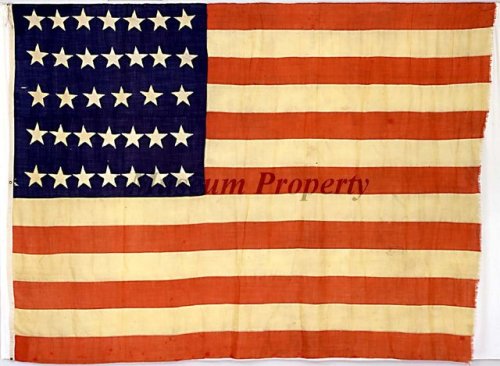#confederacy
Confederate Infantry within Jackson’s command photographed in Frederick, Maryland during the Antietam or Maryland Campaign.
12th September, 1862.
The photograph is the property of the Historical Society of Frederick County, Maryland.
Post link
Men of the 43rd Battalion, 1st Virginia Cavalry AKA Mosby’s Rangers
Colonel John Singleton Mosby is sat on the second row, third from the right.
Post link
General Pierce M.B. Young(Confederate)
Here we have a distinguished gentleman indeed. Reclining in his chair, Young is wearing the fine civilian clothes he donned for his post-war career as a politician and diplomat, although this photo was apparently taken at the height of the war itself, in 1863. His face demonstrates an unusual take on a goatee, with his remarkable moustache almost blocking out what little beard he has on his chin.
Young was one of the leading Confederate cavalry figures of the war, more or less from start to finish. He served under Wade Hampton and J.E.B. Stuart, showing bravery and leadership skills in a series of battles that eventually won him promotion to major general late in 1864. He saw out the war desperately and vainly defending his home state of Georgia and then his birthplace of South Carolina. After the surrender he returned to Georgia and served four terms in the US House of Representatives, later becoming a consul in Russia and Central America.
Post link
General James Longstreet(Confederate)
One of the most prominent generals of the war, and later one of the Confederacy’s most controversial figures, this picture of Longstreet was taken at some point after the war had ended. We find him looking well-fed and distinguished, with his salt-and-pepper beard perhaps betraying a touch of artificial help in his very dark hair.
Longstreet was one of the best generals on either side, a senior corps commander in General Lee’s Army of Northern Virginia for much of the conflict. His finest moment came perhaps at the Second Battle of Bull Run, when he led 25,000 men in the largest mass assault of the entire war to rout the Union Army’s left flank. After the war, Longstreet became the most senior Confederate to join the Republican party during Reconstruction, supporting his old military school friend Ulysses S Grant’s bid for the presidency 1868. Longstreet later served the US government in a variety of roles, including Ambassador to the Ottoman Empire. Derided as a traitor by many in the South, Longstreet was blamed for the defeat at Gettysburg and much else besides, and his reputation has only recovered in recent times.
Post link
General Stonewall Jackson(Confederate)
His beard, although impressive, is actually one of the least remarkable things about Stonewall’s general physical appearance. Convinced that one of his arms was longer than the other, he usually held one arm up in order to improve his circulation. He also chewed lemons in an attempt to ease his chronic indigestion, although his typically serious expression may have had more to do with his famously devout Christian faith than his taste for bitter citrus fruit.
An early Confederate hero, Jackson got his nickname at the First Battle of Bull Run, when his brigade of Virginians stood firm against a fierce Union assault. His Shenandoah Valley campaign, in which he skilfully manouevred his smaller force to a series of victories over much larger Union armies, gave him the reputation as one of the great generals of the war. Although undoubtedly eccentric and sometimes unpredictable (his rather sketchy performances during the Seven Days battles have been criticised by historians), his death in 1863 was a serious setback to both Southern morale and Confederate military capability. He was hit by friendly fire in the immediate aftermath of one of his greatest victories, the routing of the Union right at the Battle of Chancellorsville.
Post link
Brigadier General James Lusk Alcorn(Confederate)
Beards being so popular during 1860s America, prominent individuals explored a variety of styles in their attempts to look both fashionable and distinguished. Here, Alcorn shows off a bushy beard-and-moustache combo without any sideburns. With his hair still dark around the sides, you imagine his grey beard must have looked quite striking.
Alcorn himself wasn’t really a soldier. A lawyer and politician in Mississippi, he was an opponent of secession but joined the Confederate Army anyway, serving as a Brigadier General. Not having any military experience, he spent most of his time in uniform engaged in raising recruits and garrison duty, although he was a prisoner of war for a time in 1862. Given parole by the Union Army, he went back to his plantation and made a lot of money trading cotton. After the war he was a notable Scalawag - a Southern supporter of the Republican Party and its Reconstruction policies - and served in the US Senate and as Governor of Mississippi.
Post link
General John B Gordon(Confederate)
War is no laughing matter, but the photographic evidence suggests John B Gordon was a stern, unsmiling sort of fellow, even by the standards of the age. Just look at the dark hair, dark eyes, and that impressively dark and bushy goatee.
Soldiers with professional military experience were at a premium when the Civil War broke out, and Gordon didn’t have any. Not that it mattered. A lawyer and businessman from Georgia, he joined the Confederate Army in 1861 and rose through the ranks impressively, finishing the war as a major general. His aggressive style saw him personally wounded several times, including at Antietam where he was hit in the legs, arm, shoulder and then face, almost drowning in his own blood. A prominent Southern politician and white supremacist after the war, he served as Governor of Georgia and twice in the US Senate, as well as, according to some sources, a leader of the Ku Klux Klan.
Post link
Major General Mansfield Lovell (Confederate)
Lovell was a man who apparently did his best, both during the war and in terms of growing a sideburns-and-moustache combo. However, in both cases, his best wasn’t nearly good enough.
His facial hair shows promise, but is completely trumped by his Union contemporary Ambrose Burnside. If Burnside had been clean-shaven perhaps we’d be talking about ‘lovells’ rather than 'sideburns’ to this day. But he wasn’t, and we aren’t. In battle, Lovell was the Confederate military commander at New Orleans and took the blame for the Union capture of the city in early 1862, a crucial incident that deprived the Confederacy of its largest city for the rest of the war. Historians now suggest it was unfair to pin it all on Lovell, but that’s what the Confederate government did, and his reputation never recovered during his lifetime.
Post link
General Albert Sidney Johnston(Confederate)
The most senior general on either side to be killed in action during the war, Albert Sidney Johnston was one of the less hirsute military commanders. He had a long military career as a general in the Army of the Texas Republic as well as the US Army, and favoured just a moustache, albeit an immaculate one.
Johnston was put in charge of the huge western part of the Confederacy early in the war. He led his men into battle at Shiloh in April 1862 and was killed during a cavalry charge, apparently by friendly fire. His wound probably needn’t have been fatal, but he’d sent his personal doctor away to deal with injured Union prisoners, and the officers who went to his aid apparently had little idea of how to tie a tourniquet. One tried pouring brandy into his dying general’s mouth, unsurprisingly to little effect, and Johnston bled to death.
Post link
General PGT Beauregard(Confederate)
The Louisiana general was one of several Civil War figures to be likened to Napoleon. And there’s certainly a European look to his stylish moustache-and-sliver-of-a-beard combo.
Beauregard was a star Confederate general in the early days of the war, overseeing the bombardment of Fort Sumter that kicked the whole thing off, and then assuming command at Shiloh following the death of Albert Sidney Johnston. Beauregard arrived at Shiloh with Napoleon’s line of battle from Waterloo in his pocket, and like his hero he had to spend some time in exile when he was relieved of command following his decision to withdraw from Corinth without a fight. His later defences of Charleston and Petersburg restored his reputation, and after the war he declined offers to take charge of the armies of Brazil, Egypt and Romania.
Post link
Iroquois Confederacy found in Oatman, Arizona
from /r/vexillologyTop comment: Oh damn that’s cool. A little far from home
Post link
March is Women’s History Month
Mary Elizabeth Bowser-Freed Slave, Union Spy, and Abolitionist

Mary Elizabeth Bowser was born Mary Jane Richards on May 17, 1846, near Richmond, Virginia. She was born a slave to the Van Lew family, Eliza Baker and John Van Lew, of Richmond, Virginia.
Records show that Mary was baptized at St. John’s Church, the white congregation of the Van Lew family, as opposed to the First African Baptist Church in Richmond. This fact proves that Mary was treated differently by other slaves, by the Van Lew family from birth.

When she was of age, Eliza and John’s daughter, Elizabeth, sent Mary north to get an education. In 1885, she sent her to Liberia for missionary work and she did not return to the Van Lew home until 1860 again.
A few days after the battle of Fort Sumter, Mary married Wilson Bowser on April 16, 1861, in the same church she was baptized in. The Civil War had just begun.
During the war, Mary was instrumental in helping Elizabeth with her spy operation and aided her in helping escaped slaves take refuge in the Van Lew mansion. Mary, as well as many of the slaves freed by the Van Lew family, completed dangerous missions to get information to General Grant about the movements of the Confederate army. Mary even managed to obtain a position as a servant in the household of Jefferson and Varina Davis. She worked directly for Varina Davis and managed to learn about important strategies and plans of the Confederate government.
Soon after the war, Mary Bowser worked as a teacher to freed slaves in Richmond and, in 1867, founded her own school in Georgia. She alone taught young children and adults, all former slaves, to read and write.
A letter surviving with the date, June 1867, stated her new name as Mary Garvin and the intention that she would be joining her new husband in the West Indies.
The year of her death is unknown, but a memorial plot was placed in her memory at Woodland Cemetery in Richmond, Virginia. It honors her memory as an agent who helped saved the Union during the Civil War. The stone reads, “Mary Elizabeth Bowser, Born 1840, Union Military Intelligence Agent, She risked her life and liberty so that all could know freedom.”

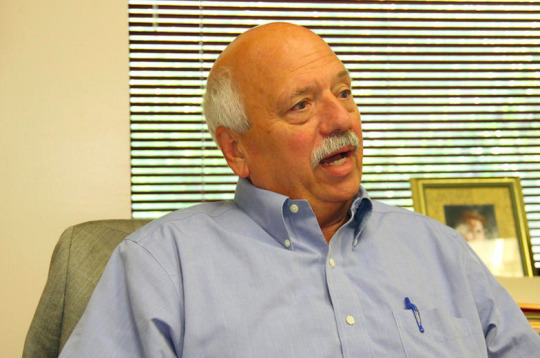
It’s not uncommon for people to try and claim that the Civil War wasn’t fought over slavery. They’re wrong but that doesn’t stop them. Georgia State Rep. Tommy Benton however has taken this to a whole new level by claiming the the Klu Klux Klan wasn’t about racism.
The Klan “was not so much a racist thing but a vigilante thing to keep law and order,” he said.
“It made a lot of people straighten up,” he said. “I’m not saying what they did was right. It’s just the way things were.
In the same interview Benton called one of his colleagues, State Rep. Vincent Fort, a “fanatic” for sponsoring legislation that would prohibit Georgia from formally celebrating holidays honoring the long defunct Confederacy. Benton also compared Fort to ISIS.
Decorated postal envelopes were popular during the mid-nineteenth century and were often collected and placed in special albums as keepsakes. During the Civil War many of these envelopes were illustrated to support the Union war effort. A set of five “Champion Prize Envelope” postal covers published by J.H. Tingley of New York City in 1861 is one example. The envelopes feature cartoons of “Lincoln & Davis in 5 Rounds” showing the Union and Confederate presidents squaring off in a roped-in boxing ring while supporters for each man look on.
In the “1st Round,” a confident Lincoln proclaims, “I use no more force than necessary” and faces a cringing Davis, who whines, “Let me alone!” Lincoln is backed by Secretary of State William Seward, a group of statesmen, and General Winfield Scott as well as Union troops and canon. An American flag flies from the Capitol dome in the background. General P.G.T. Beauregard and Confederate politicians stand with Davis, and the Confederate flag, bales of cotton, dogs, and slaves are in the background. French and British leaders watch the “belligerents” from afar.
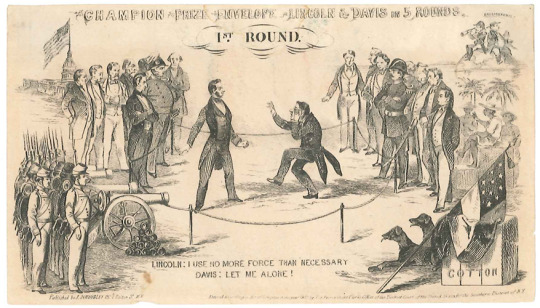
In the “2nd Round,” Lincoln tears Davis’s coattail and pants-seat as Davis runs stumbling away with his backside exposed. “Go back you dog to the junction—I’ll call on you there soon,” Lincoln declares. “Beauregard,” Davis says, “Let’s fall back on Richmond.” Union politicians comment, “Secession is looking smaller” and “We shall soon strip it,” while one Confederate bystander asks, “What strategic movement is this?” and another answers, “Only retreating in good order.” Slaves cheer at Davis’s embarrassment and defeat, and the European onlookers declare, “We are drifting into rough waters.”

In the “3rd Round,” Lincoln holds Davis in a headlock and proclaims, “I will soon smother those pirates.” The Confederate spectators flee, trampling the slaves in their path and shouting, “Let’s go home boys” and “Damn Pickens! South Carolina and Sumter too!” Canon balls litter the ring, and the starving dogs run off, abandoning the Confederate flag and cotton. The Union politicians cheer, “General, that’s secession’s last kick” and “See those balls rolling.” The French and British exit as well, noting the effective cotton blockade that the Union has put in place.

The “4th Round” shows Lincoln facing his departing Union troops and declaring, “I have taken the world by surprise.” Seward and Scott stand in the center of the boxing ring. Seward asks Scott, “General, where is secession now?” to which Scott replies, “Don’t you see that grease spot?” The remaining onlookers, including Unionists John J. Crittenden of Kentucky and John M. Botts of Virginia, strain to see what will happen next.

In the “5th Round,” a triumphant Lincoln stands in the “Champion Belt” in front of a pyramid built of all the states topped by an American flag with the letters U.S.A. Men of the North, South, East, and West wave their hats and cheer as Lincoln declares, “You shall all have my impartial, constitutional and humble protection!” The federal eagle holds a ribbon promising “Union Forever,” and Columbia holds a laurel wreath and asserts, “I still live.” Smoke from the canon carries a warning, however: “Traitors beware!! For we still live.”

These illustrated envelopes reveal the Union belief in 1861 that the war against the Confederacy would be short and Davis’s government and army easily defeated. As would soon become clear, however, that was not to be the case.
So these past few days there have been two big issues that have been brought up in the news and have many people arguing, one being the issue with the Confederate Flag and the other being Gay Marriage being ruled legal by the Supreme Court. Now I do have a few things to say about both of these topics and I am sure there will be people on both sides who agree and disagree with me on this topics.
#1. The whole issue with the Confederate flag being taken down from stores, shops, towns, etc is honestly a load of shit, yes this will offend many people, but listen to this. This particular flag doesn’t represent people fighting for slavery. There are 13 stars on that flag and these stars represent the 13 colonies who want to secede from the Union to do as they please and follow their own rules. They didn’t want to be forced to do certain things. And yes this does imply slavery to some extent with them wanting to follow their own guidelines/rules. Yes there were people in that time that lived in the south and opposed the beliefs down there, just like there were people who lived in the north that had plantations with many slaves. Not everyone in the north was against slavery and some would capture the runaways for the money, just like some in the south would harbor runaways so they could live their lives free. Hatred towards people have been around forever and there have been many crimes or shootings that have happened over the course of this year and most of them have been whites against blacks.But one incident in what was a southern state during the Civil War, shouldn’t cause for one flag that represents someones beliefs and people who wanted to think for themselves, be taken down. It is a part of history, yes an ugly part but still history. You don’t see the World trying to make Germany change their flag after the Holocaust when one group attempted genocide on another, so why make this issue different.
#2. So today Gay Marriage was ruled legal by the Supreme Court for all states. I do not have an issue with this since one of my best friends is a <b>lesbian</b>. The one issue I do have is how the courts took a shit on the Constitution and the 10th Amendment, by imposing this ruling for every state. <u>Which under this Amendment the Federal Government can only possess the powers that it is delegated to it by the Constitution, and the remaining powers are reserved to the States to decide if they want to pass something or not.</u> To me this shows how the government is taking everything into its own hands when certain issues should be decided by the States individually. I am happy for this because there are people who have been fighting for this type of equality their entire lives, but it shouldn’t be decided by the government, it should be voted on individually within the states by the people.
The Confederate raiding vessel CSS Shenandoah had the dubious distinction of accidentally firing the final shots of the Civil War. Purchased from the British, the ship was commissioned in October 1864 and dispatched to “seek out and utterly destroy” Union commerce on the high seas. Under the command of Captain James Waddell, Shenandoah journeyed halfway around the world from Madeira to Australia before entering the Pacific Ocean. Sailing north to the Bering Sea, the ship spent the summer of 1865 wreaking havoc on the American whaling fleet. In total, Shenandoah seized six vessels, burned 32 others and captured over 1,000 prisoners.
Unbeknownst to Shenandoah’s crew, almost all of this raiding took place after the collapse of the Confederacy. It was August 2, 1865, before Captain Waddell learned the war had ended, and he quickly realized that his men would be tried as pirates if apprehended by the U.S. Navy. In order to avoid arrest, he elected to voyage around the tip of southern South America and sail for England. In the process, Shenandoah became the only Confederate vessel to complete a circumnavigation of the globe. Waddell and his raiders would finally turn themselves in to British authorities on November 6, 1865—almost a full seven months after Robert E. Lee’s surrender at Appomattox.
Post link

Hello!
So, some of you might have read my lesbian western romance ‘Night Fires in the Distance’. That has since spawned a novella and a new follow up novel, titled ‘One Nation Afire’ - this follows the adventures of Rachel, hot tempered ace woman posing as a Union soldier. Utsehta, a half-Osage ten year old caught up in the Confederate army. And Laura and Cecelia, the lesbian couple from the first book, living in Confederate occupied territory.
It’s feminist, it’s action packed, it looks at race, sexuality and war - and it’s less that £4 on Amazon! I encourage you to go check out all three books in the series - Night Fires in the Distance, Smoke Through the Pines and this new instalment.
North America 160 years ago today: Attack on Fort Sumter (12 April 1861) https://buff.ly/2P4fceF Despite the Confederacy’s declaration of independence, the United States Army still garrisoned a number of forts in the south. The most vulnerable was Fort Sumter in Charleston harbor, South Carolina, which desperately needed to be resupplied. However when newly elected US President Lincoln ordered the navy to ship in supplies, the Confederate government considered it an act of war and attacked the fort from land. The American Civil War had begun. #1861 #19thcentury #americancivilwar #americanhistory #april #april12 #confederacy #fortsumter #historicalmaps #histories #historyfacts #historygram #historymajor #historymatters #historyschool #mapping #maps #northamerica #southcarolina #militaryhistory #ushistory #uscivilwar #confederatestates #victorian #victorianera #abrahamlincoln #worldatlas #todayinhistory #historytoday #thisdayinhistory (at Fort Sumter Tours)
https://www.instagram.com/p/CNj66e1gHd8/?igshid=1eekc7q7oep8e
Post link
April 3, 1865 - Confederate capital of Richmond is captured
“The Rebel capital of Richmond, Virginia, falls to the Union, the most significant sign that the Confederacy is nearing its final days.
For ten months, General Ulysses S. Grant had tried unsuccessfully to infiltrate the city. After Lee made a desperate attack against Fort Stedman along the Union line on March 25, Grant prepared for a major offensive. He struck at Five Forks on April 1, crushing the end of Lee’s line southwest of Petersburg. On April 2, the Yankees struck all along the Petersburg line, and the Confederates collapsed.
On the evening of April 2, the Confederate government fled the city with the army right behind. Now, on the morning of April 3, blue-coated troops entered the capital. Richmond was the holy grail of the Union war effort, the object of four years of campaigning. Tens of thousands of Yankee lives were lost trying to get it, and nearly as many Confederate lives lost trying to defend it.
Now, the Yankees came to take possession of their prize. One resident, Mary Fontaine, wrote, ‘I saw them unfurl a tiny flag, and I sank on my knees, and the bitter, bitter tears came in a torrent.’ Another observer wrote that as the Federals rode in, the city’s black residents were 'completely crazed, they danced and shouted, men hugged each other, and women kissed.’ Among the first forces into the capital were black troopers from the 5th Massachusetts Cavalry, and the next day President Abraham Lincoln visited the city. For the residents of Richmond, these were symbols of a world turned upside down. It was, one reporter noted, '…too awful to remember, if it were possible to be erased, but that cannot be.’”
This week in History:
March 31, 1889 - Eiffel Tower opens
April 1, 1789 - First US House of Representatives elects Speaker
April 2, 1917 - Jeannette Rankin assumes office
April 3, 1860 - Pony Express debuts
April 4, 1968 - Martin Luther King, Jr. assassinated
April 5, 1614 - Pocahontas marries John Rolfe
April 6, 1896 - First modern Olympic Games
Thisflag, reputed to be the first US flag raised over the State Capitol in Richmond by Federal occupation troops after evacuation of the city, can be found in the online collection of the American Civil War Museum.
Post link



